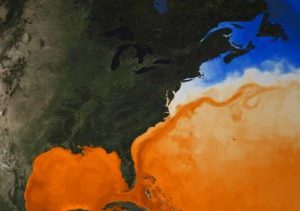The mighty Gulf Stream is an invisible force that has a vast impact on the entire planet, but very few people even know what it is! Many might guess that the Gulf Stream is a wind system, but they would be wrong. The Gulf Stream is actually a powerful ocean current; one that has a significant effect on far-flung weather systems, the Atlantic hurricane season, and annual rainfall levels for scores of countries. The influence of the Gulf Stream is felt most acutely throughout the ‘Western Hemisphere', but the domino effect caused by this massive ocean current can sometimes determine weather patterns on the other side of the planet.
The Gulf Stream, as its name suggests, originates in the Gulf of Mexico. It is a massive column of warm gulf-water that flows in a loose formation about 60 miles wide. After it exits out of the Gulf, it moves northwards up the coast of the eastern United States and into Canada. This is the reason why seawater on East Coast beaches will reach a balmy warm temperature that delights bathers. On these beaches, temperatures of 80+ degrees Fahrenheit are common, whereas the ocean water on the west coast of the US will rarely rise above 70 degrees.
After moving up the eastern coast of the US and Canada, the Gulf Stream then crosses the Atlantic and begins descending along the western coast of the UK and Europe. This influx of warm water is why some beaches of Ireland and England sport palm trees, although these countries are at the same latitude as Newfoundland and northern Canada. After brushing against the European land masses, the Gulf Stream continues south to the great continent of Africa, and it is after leaving this region that problems may develop.
Graphic visualization map of Gulf Stream seen through sea surface temperature created by NOAA NESDIS
As the Gulf Stream moves south across the western coasts of Europe, the relatively warm water of the ocean current pushes colder water before it. In a recent press release from the Potsdam Institute for Climate Impact Research (PIK), climate scientist Stefan Rahmstorf describes the Gulf Stream as a “giant conveyor belt” that moves warm surface water north while sending cold, deep water back down south. He notes that the Gulf Stream moves 20 million cubic meters of water per second- approximately 100 times the flow of the Amazon River. This cold water is pushed from the African coast into the very important waters that lie between Africa, South America, and the Caribbean region- this is the spawning ground for Atlantic hurricanes.
Recent studies have indicated that the speed at which the Gulf Stream moves is slowing down considerably. This is a topic of concern among meteorologists and climate scientists, as any changes to the Gulf Stream will have significant ramifications to weather systems. The decrease in speed is not yet fully understood, but if it were to become permanent it is possible that the great Gulf Stream could be altered in such a way that major climate repercussions would result.
This year, the National Oceanographic and Atmospheric Association (NOAA) is predicting yet another ‘above average' hurricane season. Last year (2020) was so active that it broke all the records. There were so many named storms in that year that the entire list of pre-assigned storm names was used up, as well as the full list of Greek names that serves as a back-up supply. In 2020, there were 30 named storms, of which a record-breaking 12 made landfall on the US continent.
The World Meteorological Organization (WMO), which is the agency that names the storms, realizes that this is the way of the future. This organization has now prepared a second list of names to be used in the event that all 21 names on the regular list are used up. Greek names will no longer be used, and the second list of names will automatically kick in when the 22nd named storm is formed. This is an indication that more-frequent hurricanes are now considered probable. It's not seen as likely that 2021 will equal the hyperactive hurricane season of 2020, but neither will it be a quiet year. The first named storm of 2021, Ana, arrived early in the season, which is thought to be an indicator of a heavy storm season. If the all-important Gulf Stream permanently alters its ancient habits in any significant way, the ripple effect is likely to have a major impact on the entire planet, and frequent hurricanes will be at the top of the list.
Source:: http://www.floodbarrierusa.com/








